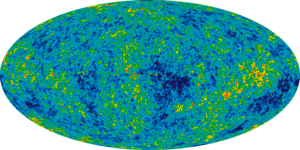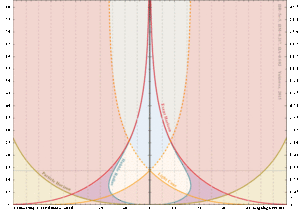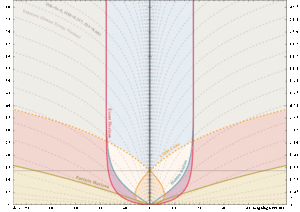Comoving and proper distances facts for kids
| Physical cosmology | ||||||||||||||
 |
||||||||||||||
| Universe · Big Bang Age of the universe Timeline of the Big Bang Ultimate fate of the universe
|
||||||||||||||
In cosmology, comoving distance and proper distance are two ways scientists measure distances in the universe. They help us understand how far away things are, especially as the universe keeps growing.
Imagine the universe is like a giant balloon being inflated.
- Comoving distance is like drawing two dots on the balloon before it's inflated. No matter how much the balloon expands, the distance *between those two dots on the balloon's surface* stays the same. This distance doesn't change because of the universe's expansion.
- Proper distance is the actual distance between those two dots *at a specific moment* as the balloon inflates. This distance changes as the universe expands.
Right now, today, the comoving distance and proper distance to any object are the same. But in the past, the proper distance was smaller, and in the future, it will be larger because the universe is always expanding.
Contents
Comoving Coordinates: A Special Way to Look at the Universe
When scientists study the universe, they often use special maps called "comoving coordinates." These coordinates are like a grid that stretches along with the universe as it expands.
Think of it this way:
- Imagine a galaxy that is just moving with the overall flow of the universe's expansion. We call this a "comoving observer" or a "comoving galaxy."
- If you were a comoving observer, the universe would look the same in every direction around you. This is because you are moving with the expansion, so you don't see things rushing away from you in one direction more than another.
- Most big things in space, like galaxies, are nearly comoving. They move mostly with the universe's expansion. Any extra movement they have (like being pulled by gravity towards another galaxy) is called their "peculiar velocity." This extra movement is usually small compared to the universe's overall expansion.
The comoving time is simply the age of the universe as measured by a comoving observer. It's like a universal clock that all comoving observers agree on.
In comoving coordinates, space is often called "static" or "unchanging." This is because if two galaxies are comoving, their comoving distance from each other stays the same, even as the proper distance between them grows due to the universe's expansion.
Comoving Distance and Proper Distance: How They Relate
Most science books and papers define comoving distance as a fixed number that doesn't change over time. Proper distance, on the other hand, is the actual distance that changes as the universe expands.
Here's a simple way to think about it:
- If the comoving distance to a galaxy is, let's say, 100 units.
- The proper distance to that galaxy at any time t is found by multiplying the comoving distance by something called the "scale factor" (which we write as a(t)).
- The scale factor a(t) tells us how much the universe has stretched or shrunk compared to today. Today, a(t) is 1. In the past, it was smaller than 1. In the future, it will be larger than 1.
So, the formula is: Proper distance = Scale factor × Comoving distance
This means if the universe has doubled in size since a certain time (so the scale factor is 2), then the proper distance to a galaxy would be twice its comoving distance.
Measuring Proper Distance
Imagine you want to measure the proper distance between two very distant galaxies. You can't just stretch a tape measure across the universe!
Instead, scientists imagine a chain of many comoving observers lined up between the two galaxies. Each observer measures the distance to the next observer in the chain. If all these observers measure their distances at the exact same "cosmological time" (meaning they all agree on the age of the universe at that moment), then adding up all those small distances gives you the total proper distance.
It's important to remember that the universe is expanding. If you calculate how fast distant galaxies seem to be moving away from us because of this expansion, you might find that some appear to move faster than the speed of light! This might sound strange, but it doesn't break any rules of physics. It's not the galaxies themselves moving *through* space faster than light. Instead, it's the space *between* us and the galaxies that is stretching and expanding. This stretching can happen at any speed.
Short vs. Long Distances
For short distances, like measuring the distance to a nearby star or even within our own galaxy, we can usually ignore the expansion of the universe. The distances are small enough, and the time it takes to travel them is short enough, that the expansion doesn't significantly change the measurement.
However, when we look at very distant galaxies, billions of light-years away, the expansion of the universe becomes very important. Over such vast distances and long periods of time, the stretching of space significantly affects how we measure and understand distances.
See also
 In Spanish: Distancia comóvil para niños
In Spanish: Distancia comóvil para niños
- Distance measure
- Expansion of the universe
- Faster-than-light#Universal expansion, for why distant galaxies can appear to move faster than light.
- Redshift, how light from distant objects gets stretched.
- Shape of the universe




